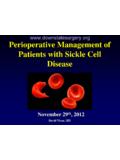Transcription of Sickle Cell - APHON
1 A Handbook for FamiliesHEMATOLOGY SERIESS ickle Cell DiseaseA Handbook for FamiliesHEMATOLOGY SERIESS ickle Cell DiseaseSICKLE CELL DISEASEA HANDBOOK FOR FAMILIESW ritten byHeather McCartney, BScN RNBeth Savage, MSN RN CPNP CPON Rebecca Selove, PhDBarbara Speller-Brown, DNP MSN CPNPWith contributions byKaren Lambert, RN Content Reviewers2014 2015 Steering CouncilParent ReviewerMelanie AndrewsABOUT THIS COVERThis cover is specially designed for your child to color and personalize. When your child finishes deco-rating the cover, return it to the clinic or doctor s office where you received the handbook. Your child s healthcare provider will then send it to APHON for posting on the APHON handbook is published by the Association of Pediatric Hematology/Oncology Nurses ( APHON ) for educational pur-poses only.
2 The material has been developed by sources believed to be reliable. The material is not intended to represent the only acceptable or safe treatment of Sickle cell disease . Under certain circumstances or conditions, additional or different treatment may be required. As new research and clinical experience expand the sources of information available concerning the treatment of Sickle cell disease , adjustments in treatment and drug therapy may be makes no warranty, guarantee, or other representation, expressed or implied, as to the validity or sufficiency of the treatments or related information contained in this 2014 by the Association of Pediatric Hematology/Oncology Nurses8735 W. Higgins Road, Suite 300 Chicago, IL Fax WHAT IS Sickle CELL disease ?
3 Sickle cell disease is an inherited blood disorder that affects the ability of red blood cells to carry oxygen throughout the body. Normally, red blood cells are round and flexible. Sickle cell disease causes red blood cells to change into a curved, or Sickle , shape. These Sickle -shaped red blood cells stick together, blocking blood flow to the hands, feet, joints, bones, and major organs. When blood flow to these areas decreases, the tissues do not get enough oxygen, causing pain and other problems. To understand how Sickle cell disease affects the body, it helps to understand a little more about WHAT IS BLOOD?Blood is a mixture of cells , proteins, and a watery substance called plasma. The cells in blood are made in our bone marrow, the sponge-like center of the bones in our skull, spine, pelvis, and ribs.
4 Like water being pumped through a hose, our blood is pumped by our heart through small tubes called blood vessels. There are two types of blood vessels: arteries and veins. The arteries carry blood away from the heart and bring oxygen to the body s tissues. The veins then return the oxygen-poor blood from the tissues back to the has many different functions. It carries nutrients and gases throughout the body to our tissues and organs. Blood carries waste products away from the tissues and organs as well. Blood also helps fight infection and heal has four major components: Plasma a yellowish liquid consisting mostly of water. Plasma acts as a river, helping the white blood cells , red blood cells , and platelets flow freely through the blood vessels.
5 It also carries nutrients, hormones, proteins, and waste products around the body. White blood cells the fighter cells , also known as leukocytes. White blood cells , which are part of the immune system, protect the body from infection and disease . Platelets the component that helps stop bleeding. Platelets form a scab after skin or tissue has been injured. Red blood cells making up the majority of the cells in our blood, these small cells , also known as erythrocytes, are slightly flattened, so they look like a doughnut with the hole filled in. The function of red blood cells is to carry oxygen, carbon dioxide, and nutrients throughout the body. Red blood cells contain a protein called hemoglobin , which carries oxygen throughout the body.
6 The red blood cells pick up oxygen in the very small vessels of the lungs and carry it to the body s tissues and organs. The cells of the tissues use the oxygen and create carbon dioxide, a waste product. After red blood cells drop off oxygen at the tissues, they pick up carbon dioxide and carry it back to the lungs to be exhaled from the HOW DOES Sickle CELL disease AFFECT THE BLOOD?Red blood cells normally contain hemoglobin A, or adult hemoglobin . In Sickle cell disease , the child inherits an abnormal gene for the production of hemoglobin , which is called a gene mutation. This gene mutation causes the body to make hemoglobin S, or Sickle hemoglobin , instead of hemoglobin A. Sickle hemoglobin is not efficient at carrying oxygen.
7 Under certain stressful conditions, such as fever and de-hydration, the red blood cells change into a rigid Sickle shape, like a crescent moon. When this happens, the Sickle -shaped cells get caught on each other and on the blood vessel walls, instead of flowing easily through the vessels like soft, round, normal blood cells . When these Sickle -shaped cells become caught on each other, they block the flow of blood through that vessel and prevent the tissues from getting fresh, oxygenated blood. This is what causes pain, the most well-known symptom of Sickle cell disease . How-ever, this lack of oxygen is also responsible for many other problems, which will be addressed blood cells that contain hemoglobin A live for almost 120 days. However, because they can Sickle and become rigid, cells containing hemoglobin S live only 10 20 days before breaking apart.
8 This breaking apart of red blood cells is called hemolysis, and the result is a low hemoglobin level in people living with Sickle cell disease . Anemia is the medical term for a low hemoglobin WHO GETS Sickle CELL disease ? Sickle cell disease is a genetic disorder, meaning it can be inherited from a parent who carries the gene mutation for Sickle cell disease . Many people associate Sickle cell disease with Africans. Although it is ex-tremely common in Africa, Sickle cell disease actually began in four areas of the world with a high incidence of malaria: Africa, India, the Mediter-ranean, and the Middle East. It is believed that the Sickle cell mutation developed as a way to protect people living in these areas from malaria. Throughout the years, intermarriage between ethnicities and popula-tion migration to other countries has made Sickle cell a global disease .
9 Today, there are people with Sickle cell disease living in almost every HOW IS Sickle CELL disease INHERITED? Sickle cell disease is inherited in the same way that many of our genetic traits, such as eye color, are inherited from our parents. Sickle cell disease is a recessive condition that occurs when a child inherits the Sickle cell gene from both parents, one from the mother and one from the father. If a child only inherits one Sickle cell gene from either parent, then he or she will have Sickle cell trait and be referred to as a carrier. People who live with Sickle cell trait do not experience the symptoms or problems that those who live with Sickle cell disease WHAT ARE THE TYPES OF Sickle CELL disease ?Although there are many types of Sickle cell disease , four types are most common: Sickle cell anemia (HbSS), Sickle hemoglobin C disease (HbSC), Sickle beta-plus thalassemia (HbS- + thal), and Sickle beta-zero thalassemia (HbS- 0 thal).
10 Sickle Cell Anemia, or hemoglobin SS (HbSS)HbSS is the most common and severe form of Sickle cell disease . In this form, each parent has passed on a mutated gene. As a result, the body produces abnormal hemoglobin . Sickle hemoglobin C (HbSC)Another gene mutation that can cause the body to make abnormal hemoglobin is hemoglobin C. If one parent passes along a mutated hemoglobin S gene and the other passes along a mutated hemoglobin C gene, the child is diagnosed with hemoglobin SC, or HbSC. Patients with HbSC tend to experience milder symptoms than those diagnosed with HbSS. However, some patients may experience the same severe symp-toms as those with Beta ThalassemiaBeta ( ) thalassemia is another inherited disorder that affects the amount and quality of hemoglobin made by the body.

